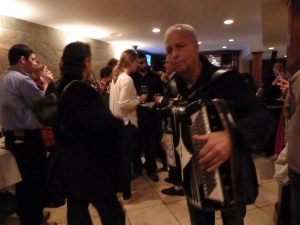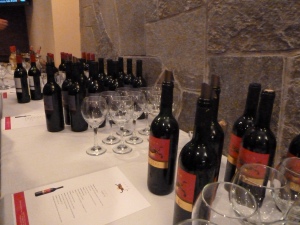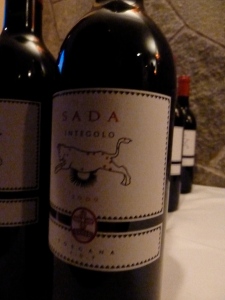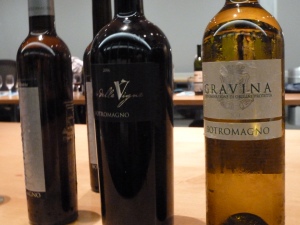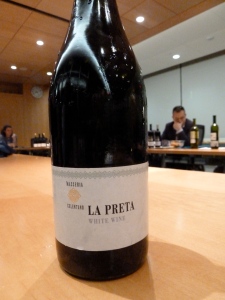In which I outline the steps to convert a white-only drinker to red-dabbler, and more on Champagne, this time vintage.
Random wine tasting notes
24 JanI’m running a tasting later this week for one of my side editorial projects. Here’s my take on some of what we’re having. They’re all available locally, and all are in the $10-$15 range.
Domaine Lafage Cote Est
A blend of grenache blanc, chardonnay and marsanne.
Located in southwest France, Roussillon borders both the Mediterranean coast and the Pyrenees Mountains separating it from Spain. As the sunniest part of France, it’s able to produce very juicy wines. You’ll notice aromas of honeysuckle, cantaloupe, iris, lime and cilantro, and flavors of ripe lime, guava, watercress, apricot, peach, tangerine rind, sea salt and white flowers. Even though this is 13% alcohol by volume, which puts it almost in full-bodied wine territory, it can work with many salads and lighter fare. For best results, pair it with rustic French or Spanish dishes, cod, grilled bruschetta, or ratatouille.
And if you close your eyes and imagine that you’re sipping this on the rue d’Antibes on the Cote d’Azur, we wouldn’t blame you.
Susana Balbos Crios Torrontes
100% Torrontes
Though it’s a white, this is the little black dress of wines: versatile, ideal for any occasion, and dang sexy (well, it is made by an Argentinian woman).
This wine is widely considered to be the epitome of Torrontes, a native Argentinean variety. It’s, simply, an irresistible tease: dry and acidic like Sauvignon Blanc, yet full-bodied, fruity and floral, with lushly perfumed aromas of peach, white pear, flowers, and orange. Rather beguiling.
Pair this baby with smoked meats, mild to medium cheeses, seafood (particularly crab and sushi). Or drink it our favorite way—by itself. Once you taste it, you’ll want to make this your house wine.
Li Veli Primonero
50% primitivo, 50% negroamaro
If this Puglia wine brings back memories of your post-college trip to Italy and a certain local attraction named Stefano, we certainly won’t tell.
Negroamaro is earthy; primitivo (depending on who you talk to, either an ancestor or twin of zinfandel) is more refined. Combining the two balance out the rougher and softer edges into a wine you can take a lot of places.
Dark, intense and plummy, with hints of black cherry, licorice, pepper and mocha, the tannins are softer than you’d expect and the nose is more floral. This is a wine that lingers nicely. It’s great for your heavier winter meals, or even for grilled foods in the summer.
My year in wine, the summary
27 DecSo 2011 was a bit of an important year for me, wine-wise because I
• Joined the Boston Sommelier Society after a whole lot of trepidation about not working in the industry for reals
• Got a subscription to Wine Spectator and didn’t open a damn issue
• Took the Australian Wine Immersion Program course.
• Started working with a startup wine site (more about this at some later point when appropriate)
• Tried Penfolds Grange
• Tried Nicolas Joly
• Spent about $2800 on wine
• Met Jean-Luc Thunevin
• Housed 150 bottles in my apartment
• Passed the CSW exam.
• Checked out Virginia’s vineyards
• Got my own personalized wino tour of Austin
• Led about two dozen wine tours in Boston for my new part-time job with City Wine Tours
• Had a bunch of fun with Red White Boston
• Tasted over 400 wines.
All that kept me busy, for sure. So expect a bunch of back-filled posts one of these days.
Introducing Sada Super-Tuscans
15 Jun“You down with IGT, yeah you know me.” Ok, so I really wasn’t singing that on my way to the June Red White Boston Tasting Crew get-together of four new-to-Boston Super Tuscans produced by Sada Estate.
A quick word about Super Tuscans, or alternately “Supertuscans.”
As many of you know, many wine regions are overseen by a local quality control board that has a lot of kooky bullshit important, constructive regulations, benchmarks and strictures in order for a wine to get the valuable, useful, lucrative marque of being from the area (in Italy usually a DOC or DOCG designation).
Sure, it’s got benefits: you don’t want someone growing Concord grapes in Albania and calling it Pauillac. Without quality control, everyone suffers. (But, IMHO, you also run the risk of wine that kinda ends up commoditized because everything tastes like everyone else from that area.) So back in the 1960s and 70s, some Tuscany winemakers decided they were going to get all sacrilegious in a sense (yeah, rebellion!), make the wines they wanted to do, and grow Gasp! French! Grapes! And! Use! Them! In! Italian! Wines! Pearlclutching to ensue!
They added mostly Cabernet and Merlot to the mix, and guess what? The world didn’t end, and the end product kicked ass–so much so that the really swanky ones like Sassacaia charge $200 a bottle. Yowza, how’s that for high-rent district? So Italy decided to be real about the sitch and create a new local designation level called indicazione geografica tipica (IGT) which basically means “we admit it’s not crap table wine, but we’re not going to entirely give in to these upstarts and let them use our hallowed DOCG name unfettered. So nyah nyah.”
So onto the show
The 2006 Carpoli , named for their region of Tuscany, was a Cab Sauvignon/Cabernet Franc/Petit Verdot blend exhorted to be savored for special occasions “with your wife, your lover….” (why not your wife and lover? That would be pretty dang special, n’est-ce pas?). It’s not made every year, only when they determine the grapes are good. It spends two years in the barrel. This one had another gorgeous garnet color I couldn’t get a good money shot of. The palate was jammier, with a texture like liquid gelatin in the fridge before it sets.
Once again, Red White Boston kicks out the jams. (Seriously Cathy, if you’re reading this, I told Terry L. we’re going to be expecting limos taking us to Sonoma by the end of the year). If you’re down with Super Tuscans, what’s your favorite? And where have you bought it?
Ciao, Apulia: Or a very nice evening with Puglian wines
18 MayPuglia (aka Apulia to the paisans) is basically the southeast heel of the Capezio boot that is italy, running for more than 200 miles along the Adriatic Sea, and mostly known for negroamaro and primitivo, and in the 1970s, crappy vermouth. It’s a region that quite frankly gets overlooked: southern Italy is poorer than the more glamorous north in general–and when you add all the super-powered wine regions up there, it’s hard to blame consumers who never drink past Umbria on the map.
You can find Puglian wines around here, but you have to look (start with Wine Bottega and Vinodivino for starters). The few I’ve had were quite enjoyable, but if you don’t think to look for them you don’t think to ask for them.
Well, a passel of winemakers there are aiming to change that. Every single email I got over the past week seemed to have some event in town for the Puglia posse. These guys were booking it all over town, meeting the industry and the well-heeled likely consumer, culminating at a dual tasting at the WGBH studios for consumers and then for the Red White Boston Tasting Crew.What struck me most was that many of the wines, both red and white, had a marked salt water taste. At first, you’d think this would be kind of nasty–I mean, salt water is what you drink when you really really really need to throw up after a night of epic alcohol consumption when you’re 16 and need to leave the slumber party and go home to your parents. (Or so I’ve heard. And don’t try this at home, kids. But I digress.)
But Puglia’s location, on the ocean, in a warm-weather region, means that the grapes have a pretty nice life and conditions to grow and ripen and all that stuff that could lead to decadence and wonderfully luxurious, unctuous fruit flavors. The salinity reins all that potential excess in so that wines end up being crisp and palate-teasing, with a good balance between fruit and acid.
Two of the standout grapes (Italy’s got something like 3,000 native varieties; you’re forgiven for not remembering these, LOL) were new to me:
Nero di Troia: one of the unusual features about this red grape is that it ripens late in the fall. In Italy, it’s been grown for volume, to be a “filler” grape. The stuff we had tonight tasted a lot more developed for only being a couple of years old–the tannins weren’t causing me to scrape my teeth down with barbed wire like a lot of young Italian reds do. And, again, the salinity was present. To be honest, Italy has a lot of cock-of-the-walk badass reds, so nero di troia might be a hard sell to most people who love their nebbiolo, unless a winery could appeal to the budget-conscious types. These would be a pretty kickass bargain.Greco: To be specific, greco bianco, imported from Greece nearly 3,000 years ago. No less an authority than Oz Clarke calls Botromagno one of the finer producers of it, even if he isn’t particularly effusive about it, calling its peachy briskness “often rather good in a neutral sort of way.” The 60/40 Greco/white malvasia blend was crisp like a Torrontes from Argentina–but it comes from Gravina, a small DOC–so small in fact, Botromagno is the only grower there.
One of the biggest, most pleasant surprises of the evening was Aglianico: Get it young, and it’s a brat of a wine: tannic and overbearing, especially if you don’t pair it with big overbearing protein-packed food. The two served last night were both pretty well-behaved. Cantine Teanum’s Otre Aglianico was a big hit for me: super brandied cherries and strawberries, rhubarb and pencil shavings (hey, that kid who ate paste in your second grade class was on to something) were held nicely in check by the saline quality of the wine. Botromagno’s Pier delle Vigne was a 60-40 Aglianico-Montepulciano blend; this one had more of a grainy “chaff” taste to it, like barley or hay, and a sulfurish “matchsticky” bite. Interesting in its own way.
Masseria Celentano’s La Preta deserves to be a cult wine someday—another example of excess and restraint. It had a luxurious nose of honeysuckle, floral and pollen, orange blossom, dry melon and mango—and counterbalanced with tobacco (which is often said about reds) and that saline taste. It’s a blend of 70% moscato and 30% sauvignon blanc. I would have preferred maybe 25-28% sauvignon blanc to make it a little less dry, but hell, I’ll take it if I can ever find it again.Gravisano Malvasia Passita was another big win for Apulia—it was the kind of dessert wine that would make Jerez shake in their soleras in fear, or, as my pal Jason Phelps at Ancient Fire Wine thought, Canadian icewine makers. Sweet without being cloying or diabetes-inducing. Believe me, when we got to take home the leftovers, I yoinked that one forthwith.
As is typical of Puritan over-regulated Massachusetts, the kicker is that these wines aren’t available here yet, so bookmark this page and check back, or print it out and take it to your local wine outfitter and tell them to tell their distributors to get on the stick. Or find a sympathetic friend in another state to front for you.So what about you? Any good experiences–travel, gustatory or otherwise–from Puglia?
A red you bring home to Mom
5 MayMy mom hates is scared of red wine. In fact, a lot of people I know are. I hear the reasons all the time: It gives me a headache/rash/other weird physical thingie. I don’t like a challenge. I only like Chardonnay, because I’m unadventurous. Or I’m so scared about how to pair things with food, I just don’t want to think about it.
So here’s an anecdote about the power of social media: I was in my neighborhood “wine store” (quotes because I find it lacking in a lot of ways) because I was too lazy to get in the car and drive to a decent wine store to pick up my assignment for my tasting group when I came across Apothic Red, which I first became familiar with because they started following me on Twitter. So, as a polite Tweet-type, I followed them back. And here they were, smack in my hood. So of course, I had to try it. Yay, power of social media!
Apothic Red 2009 is a blend of California Merlot, Syrah and Zinfandel–all fairly friendly wines. The name comes from some ‘mysterious” alleged dark ages “apotheca” where wine was stored by monks, alchemists and warlocks or whatever. That sounded like the marketing wizards in full force, but I digress.
The irony is that there’s nothing mysterious about this wine.
When you know enough about wine to a) spout your gob off without much b) a pain in the ass to undereducated wine store clerks c) sought out by your friends for recommendations, you kind of want your fermented grape juice to be a challenge. A little bit of a puzzle or challenge. Something you can tussle with. Something that’s going to stay on your mind. Kind of like dating. For me, Apothic Red was a pleasant enough encounter, but I wasn’t going to call it again.
Wine is supposed to develop and evolve from when it hits your lips to when it goes down your throat. This one didn’t. Sure, it was chockablock of cherry, strawberry, chocolate, vanilla. Things I like. And what do those things make really well? Candy. This was definitely a candy wine: easy to consume in mass quantities. It’s off-dry (which means there’s sweetness without wielding soda-level sucrosity <–no, I don't think that's a real word) and there are next to no tannins. It's a one-note wine. This is not a wine that tells of the struggle of some idealistic, dedicated vintner who works the land out of love and a little madness. You can imagine this wine has been focused-grouped and manipulated to appeal to as few objections about red as possible.
And that’s okay. And if that's your kink, that's cool. Here's one for your shopping list. You could serve this at a party and pretty much with a lot of things for dinner and mix up some decent sangria with the leftovers. It won't offend anyone.
Ironically enough, I think my mom might like it, precisely because it's not challenging. So maybe I will be bringing it home to her.
$12 from a place I’m not gonna name because while the store is nothing special, the people are nice–one of them going so far as to offer to bootleg me a copy of his MC5 documentary. Also available, according to Apothic’s website, at Blanchard’s Jamaica Plain and West Roxbury, The Urban Grape, Bauer Wines, Huntington Liquors, Reservoir Wines, Marty’s Newton, Ball Square, Gordon’s, Liquor Land, Martignetti’s and a gazillion other places.
Words fail. Just thoughts.
2 MayOn a certain day in 2001, a close friend called me to turn on the news. Tonight the Gin Savant had to call me to do the same. Thinking tonight of my college classmates and neighbors who were on doomed planes. How the nation rallied around a controversial president and how I hope we can do the same 10 years later. About a certain soldier I never knew but wish I had. About the guy who did know that soldier and would send him prayers to look after my brother-in-law on his second and third tours of duty. About that very same brother-in-law who was almost killed during the Baghdad invasion and has been dealing with issues ever since. For journalists like Daniel Pearl and the badassly brave Buffy Neuffer who died in pursuit of bringing the world the truth. For the soldiers and peaceful civilians who gave their lives for reasons and in ways that were not always clear-cut, fair, or just. About the curtailing forced upon us of our liberties.
I wanted to drink something from 2001 tonight. This Twelve Staves McLaren Vale Shiraz was the first thing I found. Calm, quiet, smooth, and comforting, with just a little unresolved, inconclusive, melancholy edge of bitterness and heat.
Pic coming soon. It was a late night watching the news and being on deadline for a client.
Back in the day circa 2003, I got this at Cambridge Discount Liquors for $24, down from $32. I haven’t seen much of Twelve Staves for sale in these parts since.
Recipe: White Trash Yuppie Sangria
11 AprSo, I finally started my taxes today. Unfortunately, the IRS won’t let me claim the 120 bottles in my wine collection as dependents so I can be a welfare queen and get my own reality show parading my utter lack of remorse and accountability around.
Instead, I’m scrabbling around the local packie for cast-off scratch tickets to claim as gambling losses my files to find scads of deductibles to get that 1099 income liability under control (I have a side copywriting business doing both sassy catalog descriptions for some Big Brand Names and really staid by-the-book financial writing on Your Retirement and Why It’s The Most Expensive and Important Purchase You’ll Ever Make. Hey, versatility!). Oh, and then I helped the Gin Savant do his taxes, and he’s getting a shitload of cash back. Which means he’s now on the hook to take me to Menton this time.
So to cope with the sticker shock of being a freeborn resident of these United States of ‘Merica, I scavenged around chez moi to help take the edge off:
• 4-5 oz (Who knows, I didn’t measure) of whatever red wine you’ve got near at hand or open (pictured: Albino Armani Foja Tonda Casetta, Urban Grape, $26)
• 6.5 oz cheap-ass strawberry soda
about half a shot of Trimbach Kirsch because that’s all that was left in the bottle (Blanchard’s Jamaica Plain, about $28)
• A squeeze of pre-fab lime juice (you’re poor. You can’t afford fresh)
• A medium-handed pour of Trader Joe’s simple syrup
• A heavy hand of Luxardo cherries and syrup (I yielded two cherries)
Stir with chopstick.
Measurements? Proportions? Hell, I’m not good with numbers; I’m a writer. Do what feels right. Add Dole canned fruit cocktail if you got it. Just make sure you have some spirits in with the wine.
I suppose if “white trash” is offensive to some, they can call it “Thrifty Girl Sangria” or “Cheapskate Calimotxo” or “Uncle Sam Hates Me.”
#70 Fer Servadou
22 MarI had to ask the sales associate three times to repeat the name of this grape. Never, ever heard of it before. She said it was one she was currently enjoying herself at home, especially with lamb.
Gaillac is in southwest France, and supposedly was the site of the oldest Roman vineyards back in the Asterix et Obelix days it was called Gaul. They have their own spin on Beaujolais Nouveau that they release in November as well, called Primeur, and is, hopefully, less galling.
I found it like a mildly spicier Pinot Noir: peppery and briny, yet eminently drinkable and friendly. It matched up well with blue cheese shortbread, and cheese and saucisson sec avec herbs de Provence. Yeah, I’m throwing in dime-store French since I never get to use it anymore. Fer also means iron, and that comes from the wood’s toughness, not the wine’s drinkability. This was tres bien.
If you can pick some up, do so.
Domaine Philemon Croix d’Azal 2008, Gaillac
Urban Grape, $12 (the orphan shelf. All gone. Sorry.)
